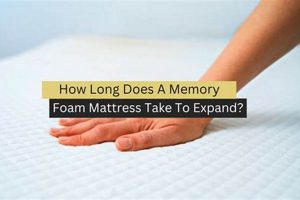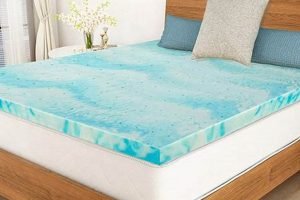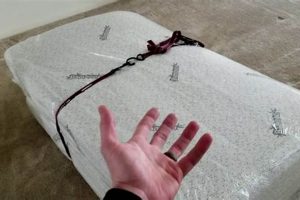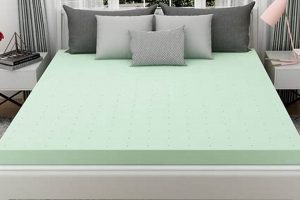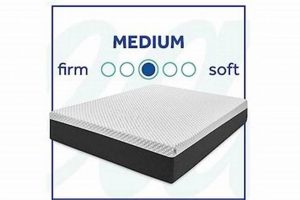The expected lifespan of a memory foam mattress is a common concern for consumers. A memory foam mattress, composed primarily of polyurethane foam with added chemicals to increase its viscosity and density, offers conforming support. Durability varies significantly, influenced by factors such as foam density, construction quality, and user care. This variability makes predicting the precise longevity a complex matter.
Understanding the factors that influence a mattress’s usable duration is important because mattresses represent a significant household investment, and directly affect sleep quality and physical well-being. Historically, innerspring mattresses were the dominant type, but memory foam has risen in popularity due to its pressure-relieving properties. The advent of memory foam necessitated a shift in expectations regarding mattress durability, maintenance and replacement schedules. A longer-lasting mattress translates to better value and a more comfortable sleeping experience over time.
Factors affecting durability, indicators of wear and tear, and strategies for extending a mattress’s usable period will be examined. Furthermore, this will explore how different qualities of foam affect its lifespan, and the role of mattress protectors and proper support foundations in ensuring lasting performance. This exploration assists in making informed decisions concerning mattress purchase and care.
Extending Memory Foam Mattress Life
Maximizing the usable period of a memory foam mattress requires proactive measures. Careful attention to the following guidelines can significantly increase its longevity and maintain its supportiveness.
Tip 1: Utilize a Mattress Protector: A waterproof, breathable mattress protector safeguards against spills, stains, and dust mites. These contaminants can degrade the foam and compromise its structural integrity. Regular washing of the protector helps maintain a hygienic sleep surface and minimizes wear.
Tip 2: Ensure Proper Bed Frame Support: The chosen bed frame must provide consistent and adequate support across the mattress’s surface. A sagging or inadequate frame can cause uneven wear, leading to premature indentations and reduced support. Slatted frames should have slats spaced closely enough to prevent sagging between them.
Tip 3: Rotate the Mattress Regularly: Rotating the mattress every 3-6 months helps distribute weight evenly, preventing body impressions from forming in specific areas. This practice mitigates concentrated stress and extends the foam’s resilience.
Tip 4: Avoid Excessive Weight Concentration: Refrain from consistently sitting or standing in the same area of the mattress, as this can accelerate wear and tear in that specific region. Distribute weight evenly when using the mattress.
Tip 5: Vacuum Regularly: Periodically vacuuming the mattress surface removes dust, dead skin cells, and other debris that can accumulate over time. This helps maintain cleanliness and prevents allergens from embedding within the foam.
Tip 6: Control Room Temperature and Humidity: Extreme temperatures and high humidity can degrade the foam’s structure. Maintain a moderate and relatively consistent environment within the bedroom to preserve the mattress’s integrity.
Following these recommendations will contribute to preserving the mattress’s comfort and support characteristics, thus helping to keep it in top condition.
Implementing these strategies, in conjunction with selecting a high-density memory foam mattress initially, greatly improves the chances of a long and comfortable sleep experience.
1. Foam density impacts longevity.
The density of the memory foam core is a primary determinant of how long a memory foam mattress lasts. Density, measured in pounds per cubic foot (lbs/ft), indicates the amount of material packed into a given volume. Higher density foams possess a greater capacity to resist compression and deformation over time. This resistance directly translates into enhanced durability and a prolonged period of usable comfort. A mattress with a low-density foam core will exhibit faster degradation, leading to sagging, body impressions, and reduced support, thereby shortening its overall lifespan. Conversely, a high-density foam mattress maintains its shape and supportive qualities for a significantly longer period, making it a more durable and cost-effective investment over time.
A real-world example illustrates this principle: a mattress with a 3 lbs/ft density foam might begin to show signs of wear and tear within 3-5 years, while a comparable mattress with a 5 lbs/ft density foam could maintain its structural integrity and comfort for 7-10 years or longer. This difference arises because the higher density foam contains more material to absorb the stresses of daily use. The practical significance of understanding this connection lies in making informed purchasing decisions. Selecting a mattress with an adequate foam density is crucial for ensuring long-term comfort, support, and value.
In summary, foam density plays a crucial role in determining the lifespan of a memory foam mattress. Choosing a mattress with a higher density foam is an investment in long-term durability and sustained performance. While higher density mattresses may have a higher initial cost, the extended lifespan and consistent comfort they provide often outweigh the price difference. Therefore, prioritizing foam density is essential when assessing the long-term value of a memory foam mattress.
2. Construction quality is a factor.
The durability of a memory foam mattress is inherently linked to its construction quality. This factor encompasses the materials used, the assembly techniques employed, and the overall craftsmanship invested in its creation. Deficiencies in construction quality invariably diminish the mattress’s lifespan. Weak seams, substandard adhesives, and low-grade cover fabrics contribute to premature wear, sagging, and structural failure. The impact is direct: a poorly constructed mattress will degrade faster, failing to provide adequate support and comfort within a shorter timeframe compared to a well-made counterpart. The correlation between construction quality and mattress longevity is significant. Example of this would be cheap foams will be used in order to meet sale quota but at the expense of mattress quality.
A crucial aspect of construction quality is the integrity of the mattress cover. A durable, well-stitched cover protects the internal foam layers from damage caused by friction, moisture, and everyday use. Inadequate cover materials are prone to tearing, allowing dust mites and allergens to penetrate the mattress core, which will affect mattress hygiene. Furthermore, the type of ad
hesives used to bond the foam layers is critical. Inferior adhesives can break down over time, causing delamination and compromising the mattress’s structural integrity. Mattresses that employ reinforced stitching, high-quality zippers, and non-toxic adhesives demonstrate a commitment to durability and longevity. Mattresses should be tested for flammability to meet market standards. This will affect construction costs of mattress.
In conclusion, construction quality exerts a substantial influence on mattress’s lifespan. Investing in a mattress manufactured with high-grade materials and meticulous assembly techniques represents a prudent strategy for ensuring long-term comfort, support, and value. While initial costs may be higher for well-constructed mattresses, the extended lifespan and sustained performance justify the investment. Paying close attention to material quality, stitching details, and adhesive types is paramount for making an informed purchasing decision and maximizing the duration of a memory foam mattress’s usable period.
3. Usage patterns affect lifespan.
The manner in which a memory foam mattress is used directly influences its durability and, consequently, its lifespan. Usage patterns encompass factors such as the sleeper’s weight, sleeping position, frequency of use, and any activities conducted on the mattress. These factors exert varying degrees of stress on the mattress’s internal structure, affecting the rate at which it degrades. For instance, a heavier individual will exert more pressure on the foam, potentially leading to faster compression and the formation of body impressions. Similarly, individuals who consistently sleep in the same position may create concentrated areas of wear, shortening the mattress’s usable period. The correlation between these usage habits and a mattress’s longevity is significant and should not be disregarded when assessing its value.
Consider two scenarios to illustrate this point. In one case, a mattress is used nightly by a single, lightweight individual who rotates it regularly and adheres to recommended care practices. This mattress is likely to maintain its supportive qualities and overall integrity for an extended period. Conversely, a mattress subjected to frequent use by multiple individuals, including children jumping or playing on it, and lacking regular rotation, will experience accelerated wear and tear. The cumulative effect of these actions is a reduction in the mattress’s lifespan, potentially leading to premature sagging, loss of support, and the need for replacement. Furthermore, individuals with certain medical conditions that cause them to spend extended periods in bed may also place additional stress on the mattress, affecting its longevity.
In summary, usage patterns constitute a critical determinant of how long a memory foam mattress lasts. An understanding of these factors allows for a more realistic assessment of a mattress’s expected lifespan. By recognizing the impact of weight, sleeping position, frequency of use, and care practices, consumers can make informed decisions regarding mattress purchase and usage. Implementing strategies to minimize concentrated wear, such as regular rotation and avoiding excessive stress on specific areas, contributes to extending the mattress’s usability. While usage patterns cannot entirely negate the effects of time, they represent a modifiable element in the equation of mattress longevity, allowing for a proactive approach to maintaining its comfort and support.
4. Maintenance procedures are essential.
Proper maintenance is an indispensable factor in determining the lifespan of a memory foam mattress. Regular adherence to recommended care practices directly influences the mattress’s durability, support, and overall hygiene. Neglecting these procedures invariably leads to accelerated wear, reduced comfort, and a shortened period of usability.
- Regular Cleaning and Vacuuming
Accumulated dust, dead skin cells, and allergens can degrade the foam and compromise its structural integrity. Regular vacuuming, ideally monthly, removes these contaminants, preserving the foam’s resilience and preventing the growth of dust mites. Spot cleaning spills promptly with a mild detergent prevents permanent stains and potential mold growth, which can damage the foam. These practices directly contribute to the longevity of the mattress.
- Mattress Protection with a Quality Protector
A waterproof, breathable mattress protector forms a barrier against liquids, stains, and allergens. It safeguards the foam core from damage caused by spills and prevents moisture from penetrating the mattress, inhibiting the growth of mold and mildew. The regular washing of the protector is essential for maintaining hygiene and preventing the accumulation of allergens. This simple measure can significantly extend the mattress’s lifespan.
- Consistent Mattress Rotation
Regular rotation, typically every 3-6 months, promotes even weight distribution and prevents the formation of body impressions in specific areas of the mattress. This practice mitigates concentrated stress on the foam, ensuring uniform wear and tear across the entire surface. Consistent rotation preserves the mattress’s support and comfort, extending its usable lifespan.
- Appropriate Foundation and Support
A stable and supportive bed frame or foundation is critical for distributing weight evenly and preventing sagging. Inadequate support can cause premature wear and tear, leading to indentations and reduced support. Ensuring that the mattress rests on a solid, level surface prevents undue stress on specific areas, maximizing its lifespan.
The effectiveness of maintenance procedures in preserving a memory foam mattress’s lifespan underscores the importance of proactive care. By consistently implementing these strategies, consumers can significantly extend the period of comfortable and supportive sleep. The investment in regular maintenance translates into prolonged mattress performance, enhancing its value and ensuring a healthier sleep environment.
5. Foundation support contributes duration.
The relationship between mattress foundation and longevity is critical to understanding the usable period of a memory foam mattress. A properly chosen and maintained foundation provides essential support that directly impacts the mattress’s ability to withstand daily stresses and maintain its structural integrity, thereby affecting how long a memory foam mattress lasts.
- Even Weight Distribution
A solid, level foundation ensures even weight distribution across the mattress surface. This prevents concentrated stress in specific areas, mitigating the formation of body impressions and premature sagging. A foundation with inadequate support, such as one with widely spaced slats or a weak center support, can cause localized stress, accelerating wear and tear and ultimately shortening the mattress’s lifespan.
- Prevention of Sagging and Deformation
Sagging is a primary cause of mattress discomfort and reduced support. A sturdy foundation prevents sagging by providing consistent support across the entire surface. Without this support, the mattress’s internal structure can deform over time, leading to uneven weight distribution and compromised comfort. A foundation designed to complement the mattress type, such as a platform bed or a box spring designed for memory foam, is crucial for maintaining its shape and extending its longevity. Example of this is memory foam needs a flat surface and sprung divans do not provide the required support.
- Impact on Warranty Validity
Many mattress manufacturers specify foundation requirements in their warranty terms. Using an unsuitable or damaged foundation can void the warranty, leaving the consumer responsible for repair or replacement costs if the mattress fails prematurely. Adhering to the manufacturer’s recommendations regarding foundation type and support is not only essential for maximizing the mattress’s lifespan but also for preserving warranty coverage. For example, many manufacturers require the use of a specific type of foundation to maintain warranty validity, otherwise, the warranty will not cover mattress issues. Failure to do so and the mattress will not be covered.
- Promotion of Air Circulation
Some foundation designs promote airflow beneath the mattress, helping to prevent moisture buildup and the growth of mold and mildew. Adequate air circulation contributes to a healthier sleep environment and can prevent premature degradation of the mattress’s internal materials. Foundations with breathable designs, such as slatted platforms or open-coil box springs, can help regulate temperature and humidity, extending the mattress’s lifespan.
The contribution of foundation support to a memory foam mattress’s duration is undeniable. Selecting an appropriate foundation, ensuring its proper installation, and maintaining its integrity are essential steps for maximizing the mattress’s lifespan and preserving its comfort and support characteristics. A well-supported mattress will withstand daily stresses more effectively, maintain its shape for a longer period, and provide a more comfortable and restful sleep experience over time.
Frequently Asked Questions
The following questions address common inquiries concerning memory foam mattress longevity and factors influencing its lifespan.
Question 1: What is the typical lifespan of a memory foam mattress?
The expected lifespan of a memory foam mattress typically ranges from 7 to 10 years. This range is influenced by factors such as foam density, construction quality, usage patterns, and maintenance procedures.
Question 2: Does foam density affect how long a memory foam mattress lasts?
Yes, foam density is a significant factor. Higher density foams generally exhibit greater resistance to compression and deformation, resulting in a longer lifespan. Mattresses with lower density foams tend to degrade more rapidly.
Question 3: How does construction quality influence a memory foam mattress’s lifespan?
Construction quality directly impacts durability. Mattresses constructed with high-quality materials, reinforced seams, and durable adhesives tend to outlast those with weaker construction.
Question 4: Can usage patterns affect how long a memory foam mattress lasts?
Yes, usage patterns play a role. Factors such as sleeper weight, sleeping position, frequency of use, and activities conducted on the mattress contribute to wear and tear. Consistent weight distribution and proper care can mitigate premature degradation.
Question 5: What maintenance procedures can extend the lifespan of a memory foam mattress?
Regular vacuuming, spot cleaning, the use of a mattress protector, consistent rotation, and ensuring proper foundation support are essential maintenance procedures. These practices help preserve the mattress’s integrity and extend its usable period.
Question 6: How does the foundation support contribute to a memory foam mattress’s longevity?
A stable and supportive foundation ensures even weight distribution, preventing sagging and deformation. Using an appropriate foundation, as recommended by the manufacturer, is crucial for maximizing the mattress’s lifespan and preserving warranty validity.
In summary, the longevity of a memory foam mattress is determined by a confluence of factors, including material quality, construction techniques, usage patterns, and maintenance practices. Addressing these considerations proactively can optimize mattress performance and extend its lifespan.
The subsequent section will provide guidance on selecting a memory foam mattress that aligns with individual needs and preferences.
Determining Mattress Longevity
This exploration has comprehensively addressed how long does a memory foam mattress last. Key factors influencing the timeframe, including foam density, construction quality, usage patterns, and maintenance, have been detailed. Acknowledging the interplay of these elements facilitates a more informed understanding of expected mattress performance.
The information provided serves as a valuable resource for assessing the long-term value proposition of a memory foam mattress. Implementing the recommended maintenance strategies and selecting a product aligned with individual needs will optimize the investment and contribute to a more comfortable sleep environment. Prioritizing these considerations ensures a more satisfactory and extended mattress lifespan.


